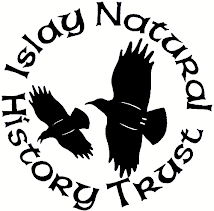We at the Islay Natural History Trust had an amazing weekend
(8th & 9th April) learning about the seaweeds on the shore.
I am so glad we finally managed to arrange this and discovered the
expertise not so far away on Easedale with Duncan (Slate Island Seaweeds
Ltd). Two seaweed workshops over last
weekend attracted 31 participants all eager to discover what bounty the
seashore could provide. We learned that
there was more to seaweeds than meets the eye, not just a slimy mass of algae
that when past it's best creates 'stinky corners'!
Foraged fresh and sustainably and with the right know-how in how to cook it, it is a wonder to the pallet. There are the green seaweeds, similar to terrestrial plants, the reds, mid to low shore, a whole host of tender edible varieties and the brown seaweeds a group all themselves and none of them perilous to eat unlike fungi. So we were treated to alfresco cooking in the lovely weather, on the beach at Sanaigmore and in the Youth Hostel garden in
 |
| Cookery demonstration in the SYHA garden |

Purple Laver grows in profusion on many of our shores coating rocks in a shiny black film. This is the basis for laverbread and the noki used in sushi, but dried and baked in the oven makes amazing crisps, far better than potato crisps and so much healthier! Pepper Dulse has an amazing flavour, though not according to my daughter! Although our younger participants on the Sunday were first in the queue trying all the flavours that were presented to them.
 |
| taste testing on the beach |
Traditional Carageen pudding went down very well, and Carageen was used as a thickening agent for egg-less pancakes.
 |
| False Irish Moss (alternative to Carageen) thickening milk for eggless pancakes |
 |
| Wild garlic and pepper dulse pesto |
So hopefully it has inspired many of us to consider being a little more adventurous in our cooking, it certainly has for me, I came home and cooked nettle soup for my tea.
Saturday foraging crowd:
 |
| Taste testing everything |

 |
| Eager students |

 |
| The best finds on the lowest turn of the tide |
 |
| Velvet Horn |
 |
| Smooth periwinkle enjoying Pepper dulse too! |
 |
| Peering into pools |
 |
| Our eager participants on Port Charlotte beach on Sundays Workshop |
Sunday's foraging:
 |
| Lovely crowd for Sunday's workshop |
 |
| Eager to try wild garlic and pepper dulse pesto |
 |
| George Jackson sampling Duncan's seaweed treats |
Fiona MacG


















No comments:
Post a Comment